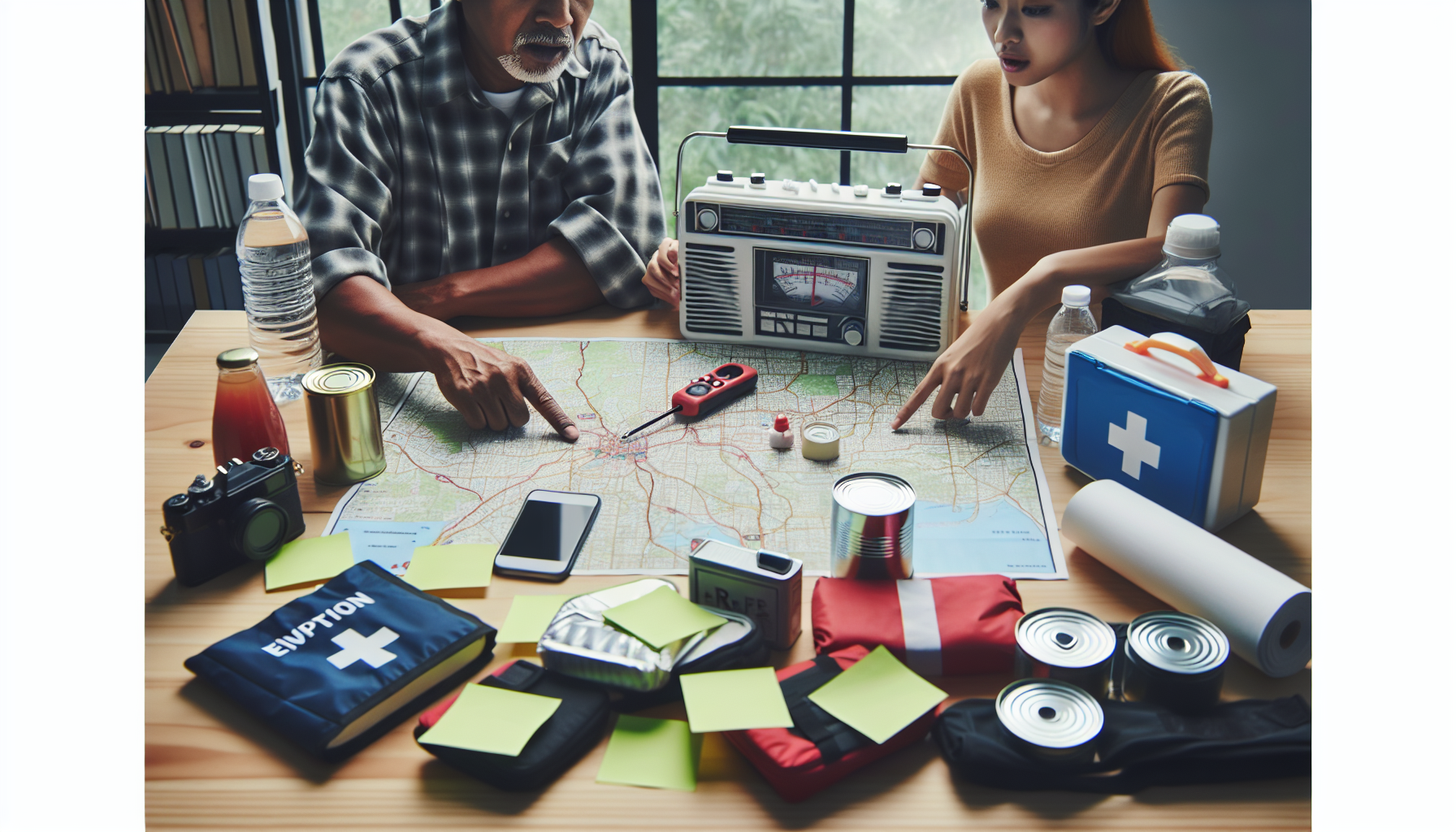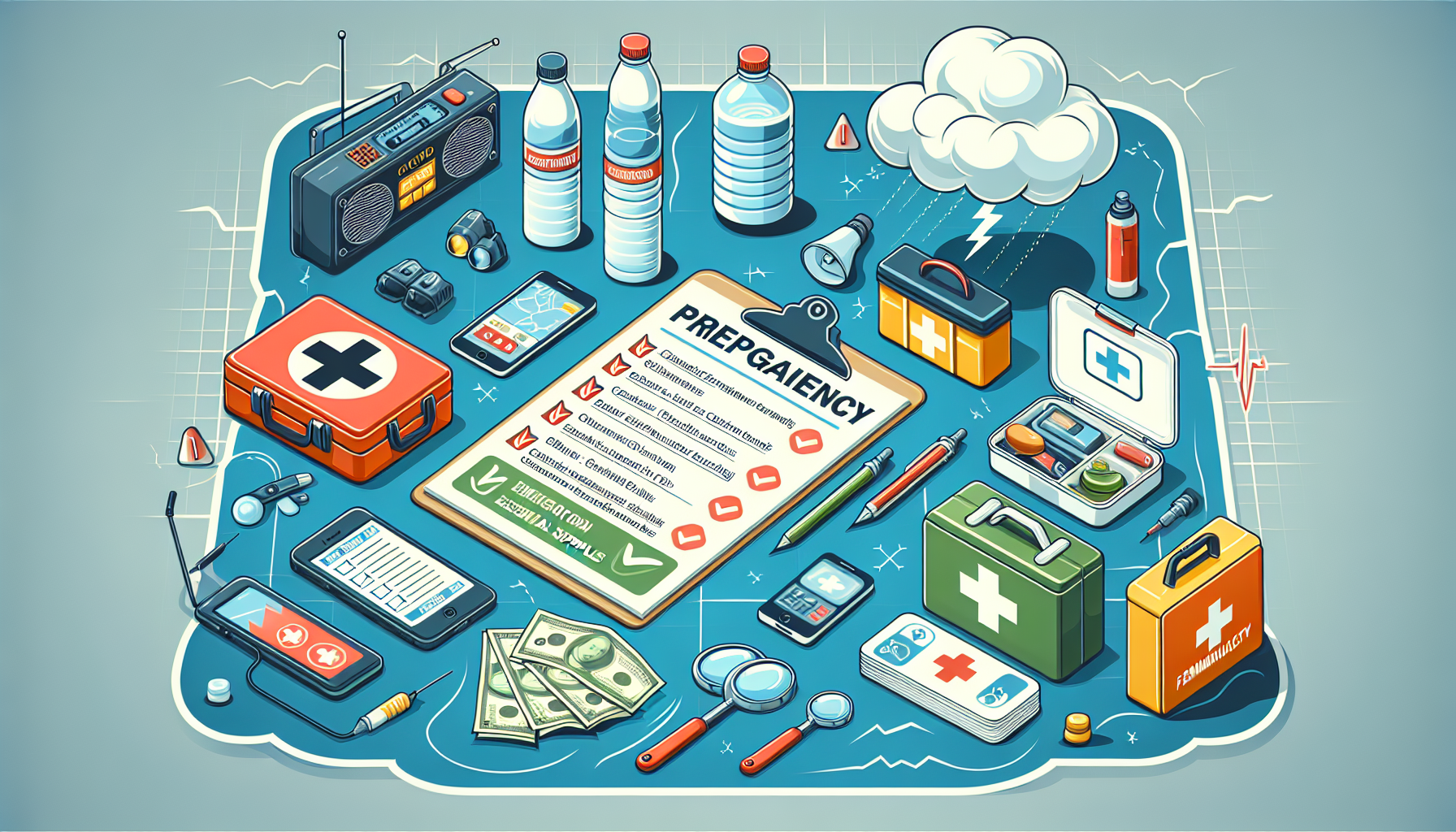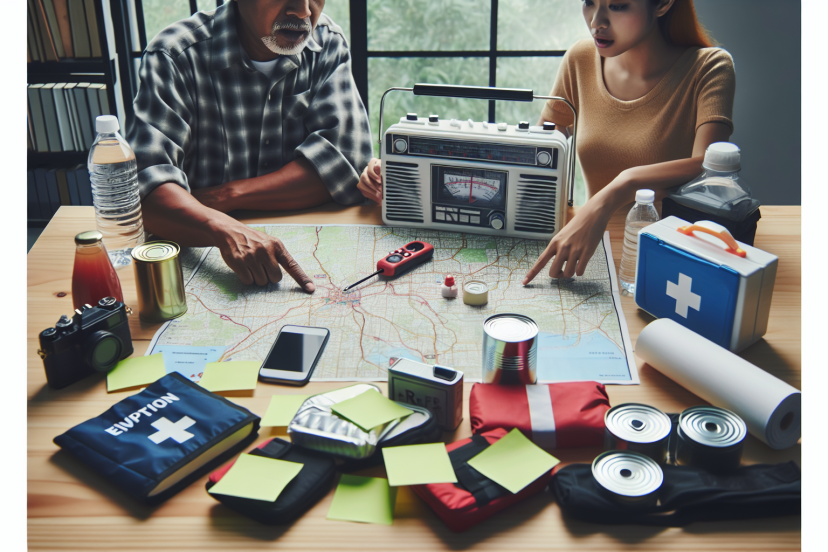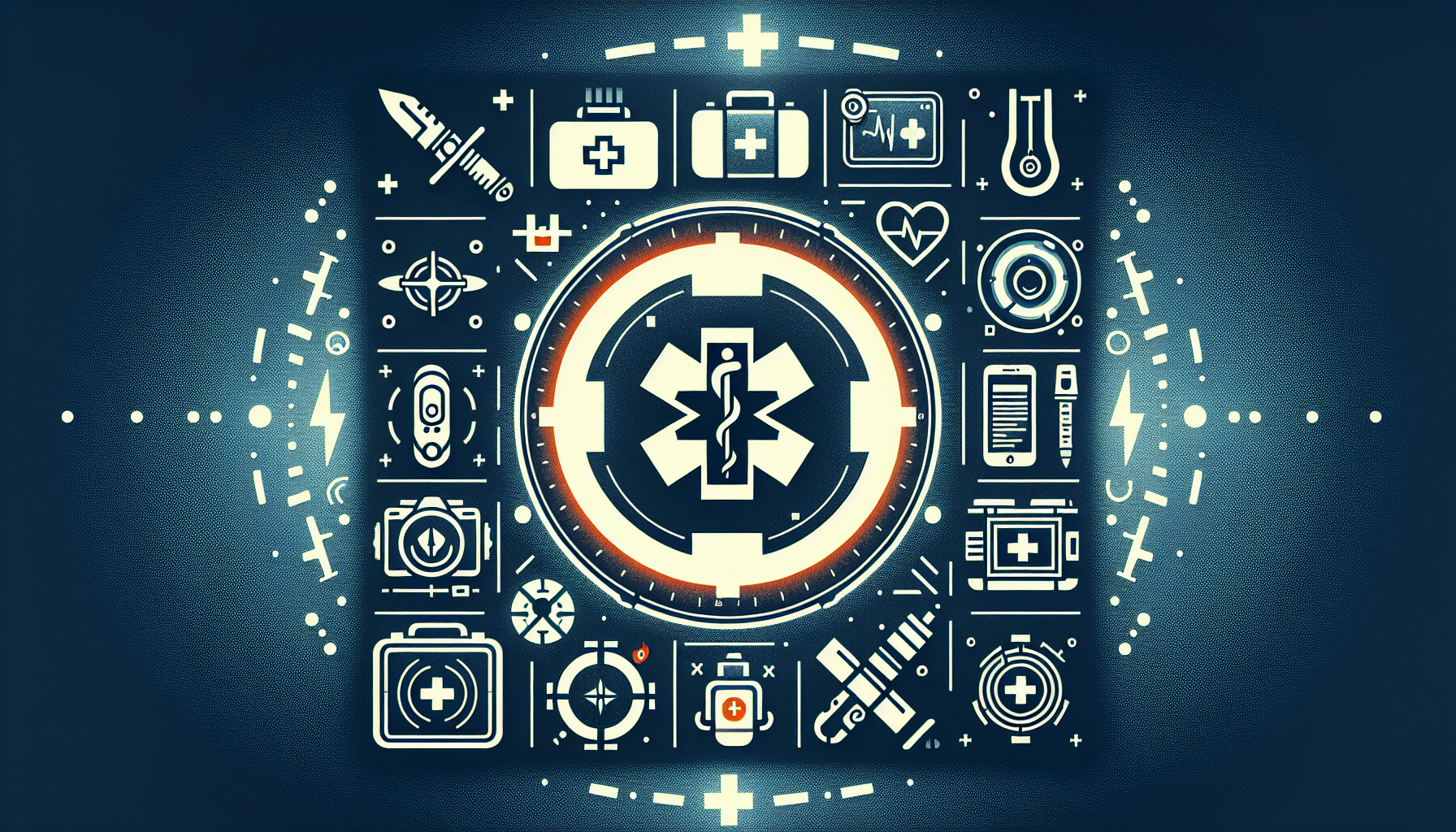How To Create A Basic Emergency Preparedness Plan
If the unexpected strikes, having a basic emergency preparedness plan in place can make all the difference in ensuring the safety and well-being of yourself and your loved ones. From natural disasters to unforeseen accidents, being prepared for any emergency scenario is essential. In this article, you will discover practical steps and useful tips on how to create a basic emergency preparedness plan that can help you navigate through challenging times with confidence and peace of mind.
Understanding the Importance of Emergency Preparedness Plan
Why emergency preparedness is crucial
Emergency preparedness is crucial because it allows you to effectively respond to unexpected situations and protect yourself, your loved ones, and your property. Disasters, whether natural or man-made, can strike at any time. By being prepared, you can minimize the impact of these disasters and potentially save lives.
The benefits of having a plan in place
Having an emergency preparedness plan in place provides numerous benefits. First and foremost, it ensures that everyone in your household knows what to do and where to go in the event of an emergency. This can help reduce panic and confusion, allowing for a more efficient response. Additionally, having a plan helps you prioritize your actions and allocate resources effectively. It also allows you to communicate your needs and whereabouts to family members, neighbors, and emergency responders, increasing the likelihood of receiving timely assistance.
Common misconceptions about emergencies
There are several common misconceptions about emergencies that can hinder effective preparedness. One misconception is that emergencies only happen to other people or in specific regions. The truth is that emergencies can occur anywhere and affect everyone, regardless of their location or background. Another misconception is that emergencies will always be short-lived or easily managed. In reality, some emergencies can last for extended periods, requiring sustained preparedness and resources. It is also a misconception to believe that emergency services will be able to immediately respond to every individual’s needs during a disaster. By understanding and dispelling these misconceptions, you can better prepare yourself for any emergency situation.
Assessing Potential Risks and Hazards
Identifying natural disasters
To effectively prepare for emergencies, it is essential to identify the potential risks and hazards specific to your location. This includes recognizing the natural disasters that can occur in your region, such as earthquakes, hurricanes, floods, wildfires, or tornadoes. Researching the history of your area and consulting local emergency management agencies can provide valuable information on the likelihood and severity of these events.
Determining man-made threats
In addition to natural disasters, it’s essential to consider man-made threats that could pose a risk to your safety. These threats can include industrial accidents, chemical spills, terrorist attacks, or civil disturbances. Understanding the potential man-made hazards in your area allows you to take specific precautions and tailor your emergency preparedness plan accordingly.
Assessing location-specific risks
Each location has its own unique risks and vulnerabilities. Coastal areas may be prone to hurricanes, while mountainous regions may have a higher risk of avalanches. Identifying the location-specific risks in your area helps you prioritize your preparedness efforts and take appropriate preventive measures.
Considering health-related emergencies
Health-related emergencies, such as pandemics or disease outbreaks, can also occur. Understanding the potential health risks and having contingency plans in place, such as having a sufficient supply of necessary medications, can contribute to a robust emergency preparedness strategy.

Creating a Personal Emergency Kit
Gathering essential supplies
Creating a personal emergency kit is essential to ensure you have necessary supplies in case of an emergency. This kit should include items such as non-perishable food, water, flashlights, batteries, a battery-powered radio, a first aid kit, prescription medications, personal hygiene items, and a multi-purpose tool. It is also advisable to include any items specific to your family’s needs, such as infant formula or pet supplies.
Important documents to include
Including copies of important documents is crucial in an emergency. These documents may include identification cards, passports, insurance policies, medical records, and proof of address. Keeping these documents in a waterproof and portable container ensures their accessibility and protects them from damage.
Emergency food and water requirements
In an emergency, access to food and water may be limited or cut off entirely. It is crucial to have an ample supply of non-perishable food and water for each family member, with a recommended stockpile that can last at least three days. Consider options with a long shelf life, such as canned goods, energy bars, and pouches of water.
First aid kit essentials
A well-stocked first aid kit is vital in any emergency situation. It should include items such as bandages, antiseptic wipes, pain relievers, adhesive tape, gloves, tweezers, and a basic first aid manual. Additionally, consider any specific medical needs of your family members, such as prescription medications or specialized medical supplies.
Additional items for specific needs
It is important to consider the unique needs of your family members when assembling the emergency kit. This may include items such as baby supplies, pet food, extra clothing, blankets, or any necessary medical equipment. Adapting the emergency kit to address individual needs ensures that everyone’s safety and well-being are accounted for.
Developing an Emergency Communication Plan
Establishing a family or household emergency contact
In an emergency, communication can be challenging, and traditional communication methods may be disrupted. Establishing a designated family or household emergency contact is essential for maintaining communication during a crisis. Choose a relative or friend who lives in a different area, as they may be easier to reach and can serve as a central point of contact for everyone in your family.
Choosing alternative communication methods
During emergencies, traditional communication channels, such as phone lines or cellular networks, may become overloaded or unavailable. It is crucial to identify alternative communication methods, such as text messaging, email, social media, or two-way radios, which can be invaluable in staying connected with family members, neighbors, and emergency services.
Creating a meeting place or rendezvous point
Having a designated meeting place or rendezvous point is crucial in case your family members are separated during an emergency. Choose a location that is easily accessible and familiar to everyone, preferably outside your immediate vicinity, to ensure safety and ease of identification.
Assigning roles and responsibilities
Assigning roles and responsibilities to each family member ensures a coordinated response during an emergency. Designate tasks such as gathering emergency supplies, contacting authorities, or caring for children or elderly family members. Clearly defining these roles beforehand eliminates confusion and helps maintain order and efficiency.

Preparing an Evacuation Strategy
Understanding evacuation routes
In certain emergencies, evacuation may be necessary to ensure your safety. Familiarize yourself with the evacuation routes in your area and have maps readily available. Consider multiple escape routes and establish alternative routes in case primary routes become blocked or unsafe.
Creating a packing checklist
When preparing for evacuation, it is essential to have a packing checklist to ensure you have all necessary items. This list should include essential documents, such as identification papers, personal hygiene items, clothing, medication, a first aid kit, emergency food and water supplies, and any important personal belongings.
Planning for transportation
Transportation may be limited during an emergency, so it is crucial to plan for alternate means of transportation. If you have a vehicle, ensure it is in good working condition and maintain a sufficient fuel level. If you do not have access to a vehicle, consider alternative options, such as public transportation or coordinating with neighbors or community members.
Making arrangements for pets or livestock
Pets and livestock are a part of our families, and their safety should be considered in emergency planning. Identify pet-friendly shelters or accommodations in advance and ensure you have necessary supplies, such as food, water, medications, and carriers or leashes. If you have livestock, make arrangements with neighboring farms or facilities to ensure their well-being during an evacuation.
Identifying potential emergency shelters
In some emergencies, seeking shelter outside your home may be necessary. Identify potential emergency shelters in your area, such as community centers, schools, or designated evacuation sites. Familiarize yourself with their locations and any specific guidelines or requirements for accessing these facilities.
Securing Your Home or Property
Securing doors, windows, and entry points
Securing your home or property is essential to prevent unauthorized access during emergencies. Reinforce doors and windows with sturdy locks or storm shutters. Consider installing security film on windows to make them more resistant to impact. Additionally, use deadbolts or reinforcing bars to further secure entry points.
Preventing water damage
Water damage can be a common issue during emergencies, particularly due to floods or storms. Take preventive measures such as installing sump pumps or waterproofing basement walls. Ensure gutters and downspouts are clear of debris to prevent water buildup. Consider elevating valuable or sensitive items to minimize potential damage.
Protecting important documents
Important documents, such as identification papers, insurance policies, or financial records, should be protected during emergencies. Store physical copies in a fireproof and waterproof container or consider digitizing them and storing them securely online or on a portable storage device. Keep backups of electronic copies in a separate location.
Shutting off utilities
In certain emergencies, it may be necessary to shut off utilities to prevent further damage or hazards. Locate and familiarize yourself with the shut-off valves for gas, water, and electricity in your home. Ensure necessary tools, such as a wrench, are readily available to facilitate this process. Teach other family members how to shut off utilities as well.
Considering additional security measures
Depending on your specific circumstances, you may need to consider additional security measures to protect your home or property. Installing security cameras, motion sensor lights, or an alarm system can be effective deterrents. Assess your property’s vulnerabilities and consult with security professionals if needed.
Developing Emergency Response Procedures
Creating an emergency contact list
In addition to the designated family or household emergency contact, it is essential to create an emergency contact list that includes important phone numbers, such as local authorities, medical professionals, insurance companies, and utility providers. Having these numbers readily available can streamline communication and expedite necessary actions during emergencies.
Establishing protocols for different scenarios
Different emergencies call for different responses, and it is crucial to establish protocols for various scenarios. Outline procedures for fires, earthquakes, severe weather, chemical spills, or any other potential threats specific to your location. Clearly communicate these protocols to all family members and regularly review and practice them.
Training family members or employees
Training family members or employees in emergency response procedures is essential for ensuring a coordinated and effective response. Conduct regular drills and exercises to practice evacuation routes, communication methods, and other emergency protocols. Encourage active participation and provide clear instructions on actions to take during different situations.
Assigning responsibilities during emergencies
During emergencies, having assigned responsibilities ensures that everyone knows what is expected of them and helps maintain order. Assign individuals to specific tasks, such as contacting emergency services, gathering supplies, or providing first aid. Regularly review and update these assignments as needed, considering changes in family dynamics or workplace structures.
Staying Informed and Monitoring Alerts
Utilizing reliable sources of information
To stay informed during emergencies, it is crucial to rely on accurate and trustworthy sources of information. Stay updated through official channels such as local government websites, national emergency management agencies, and trusted news outlets. Avoid spreading or believing rumors and actively verify information before sharing it with others.
Signing up for emergency alerts
Many communities offer emergency alert systems that provide timely information and updates during crises. Sign up for these services to receive alerts via text message, phone call, or email. Ensure that all family members are registered and that their contact information is up to date.
Following local news and weather updates
Local news outlets and meteorological services provide valuable information on developing situations, weather patterns, and potential hazards. Stay tuned to these updates, particularly during severe weather events or other emergencies. Social media accounts of reliable news sources can also provide real-time updates.
Monitoring social media for updates
Social media platforms can be a valuable tool for staying informed during emergencies. Follow official accounts of local government agencies, emergency management organizations, and recognized news sources. Be cautious of misinformation and rely on verified sources for accurate information.
Testing and Reassessing Your Plan
Conducting regular emergency drills
Regularly conducting emergency drills is essential to ensure that everyone is familiar with the established procedures and can confidently respond during an actual emergency. Simulate various scenarios and evaluate the effectiveness of your plan. Use these drills as learning opportunities to identify areas for improvement and reinforce good practices.
Identifying weaknesses or areas for improvement
During and after each emergency drill, assess the weaknesses or areas for improvement in your emergency preparedness plan. Consider any challenges or obstacles that arise during the simulation and brainstorm solutions to address them. Continually seek feedback from family members, employees, or other stakeholders to enhance the effectiveness of your plan.
Updating your emergency kit and supplies
Emergency kits and supplies should be regularly updated to ensure that they remain functional and up to date. Evaluate the expiration dates of food, water, medications, and batteries, replacing them as necessary. Review your inventory and assess if any additional items are needed based on changing circumstances or personal needs.
Reevaluating and adapting your plan
As circumstances change, it is crucial to reevaluate and adapt your emergency preparedness plan accordingly. Changes can include shifts in family dynamics, relocation to a new area, or updated information on potential risks. Regularly review and revise your plan to ensure its continued relevance and effectiveness.
Sharing Your Emergency Preparedness Plan
Informing family members or loved ones
Informing your family members or loved ones about your emergency preparedness plan is vital for their safety and peace of mind. Clearly communicate the details of your plan, including evacuation routes, designated meeting places, and assigned roles and responsibilities. Encourage open dialogue and ensure everyone understands their role in implementing the plan.
Communicating with neighbors or community
Engaging with your neighbors or community members in emergency preparedness efforts can foster a sense of collective security. Share relevant information about potential risks, evacuation plans, and available resources. Establish a system for mutual assistance during emergencies, such as sharing essential supplies or providing support to vulnerable individuals.
Coordinating plans with schools or workplaces
If you have children attending school or you are part of a workplace, it is essential to coordinate emergency preparedness plans with these institutions. Understand their protocols for emergencies, including evacuation procedures and communication methods. Ensure that their plans align with your own family or household plan to ensure a seamless response during emergencies.
By following these guidelines and implementing a comprehensive emergency preparedness plan, you can significantly increase your ability to respond to emergencies effectively. Remember, preparedness is a continual process, and regularly reviewing and updating your plan ensures that you are equipped to face any unexpected situation with confidence and resilience. Stay safe and be prepared!




